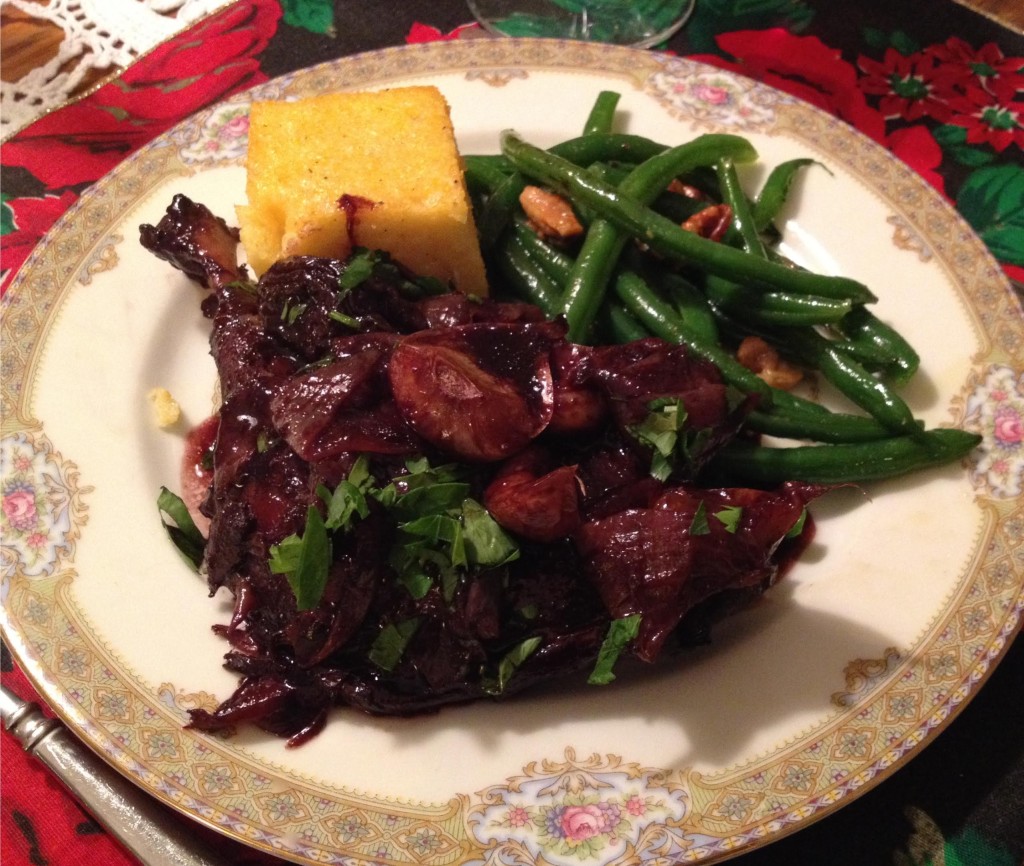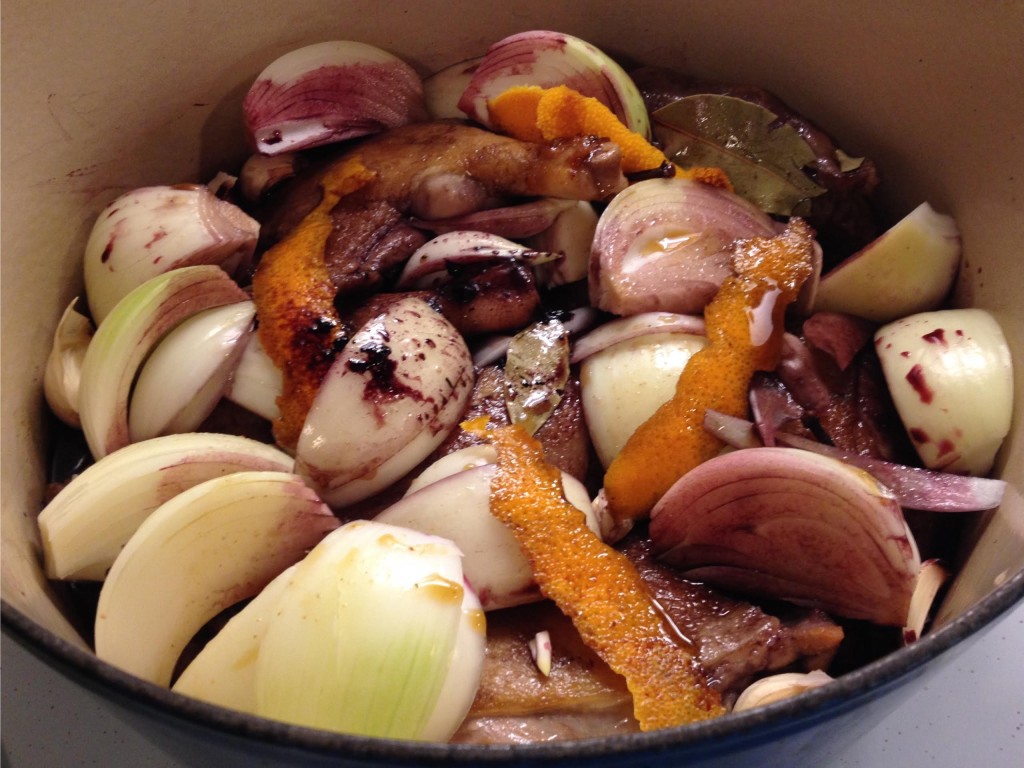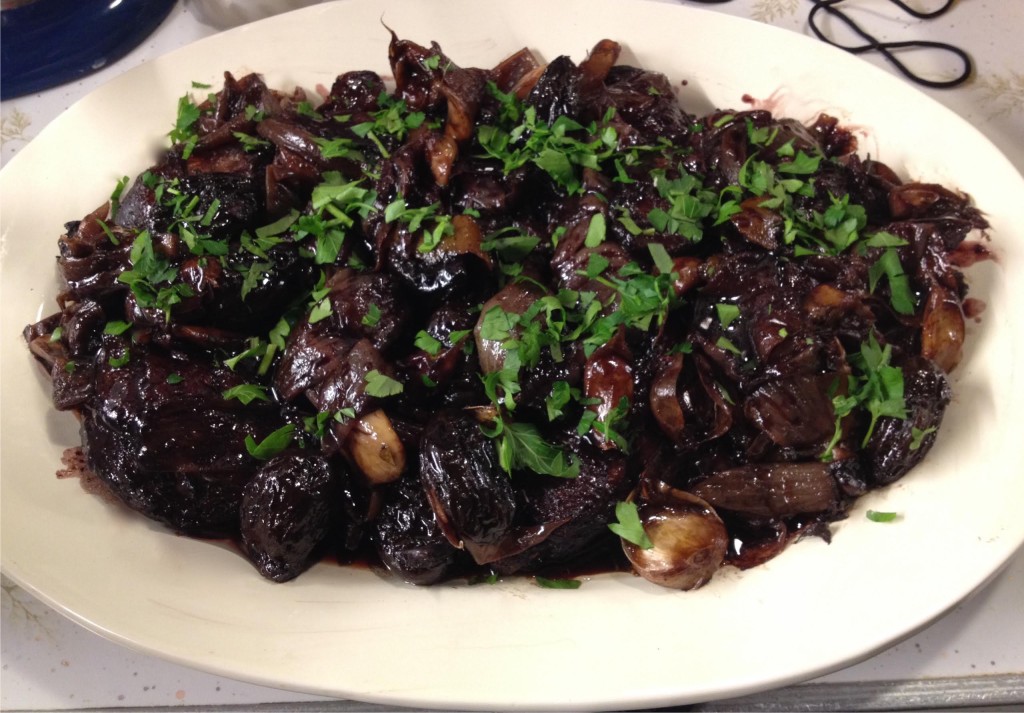Duck Braised with Red Wine and Prunes

I took Judy’s advice and served it with sauteed polenta, along with some green beans tossed with olive oil and toasted walnuts.
I have been wanting to tell you about this dish. It is so delicious, silky in texture, totally yummy and best yet, it’s super easy. You just need time, so a weekend is good. This Duck Braised with Red Wine and Prunes is a recipe from the famed Judy Rodgers, the chef and owner at Zuni Café in San Francisco. She left us way too soon, just a little over a year ago when she was only 57. (cancer) I feel a kindred spirit with Judy. She was also from St. Louis and she loved great basic food perfected. She was known for refined simplicity.
Her Zuni Café cookbook is different. Her recipes read like she is standing next to you, telling you what to expect, variations that may come up and what to do. Therefore, all recipes are very copy heavy, which is a little intimidating and time consuming to get through it all. But the upside is, she is teaching you HOW to cook, with tips all the way through on every possibility that may come up, and why, not just how to cook that particular recipe.
She has a definite fondness for salting the proteins early, even days before. If you think about it and can do it, it really does work. It tenderizes, promotes juiciness, improves texture, and flavors the meat or poultry all the way through. It’s interesting, that by seasoning judiciously early, you will use less salt overall. As Judy says, “you will eliminate the habit of repeated doses, and accidental overdoses, of “surface salt” at the table.”
One of my all-time favorite dishes of hers to make, and it is the most popular dish at the restaurant, is her Zuni Roast Chicken with Bread Salad. It takes an hour to order at the café, but that hasn’t put a damper on its demand. I’ll have to share that at another time.
Because I love her roast chicken so much, I thought she couldn’t go wrong with duck, right? She did not disappoint. Here is her recipe. I made it with LOVE for our friends Margaret and Wayne during the holidays, using 6 duck legs and increasing the recipe proportionately, and then we got to have another dinner out of it later that week.
DUCK BRAISED WITH RED WINE & PRUNES – serves 4 – a Judy Rodgers recipe
A rich old French dish. If you use the orange zest or the clove, it will have a dramatic impact on the flavor and character of the dish, making it sneakily festive. I like it both ways. (I used both the orange and cloves)
Muscovy, or Barbiere (Barbary), duck has firm, almost beefy, dark red flesh that supports long cooking and generous old-fashioned flavors. Very good with toasted polenta.
Wine: Cabors, Chateau du Cayrou, 1996
For 4 Servings:
4 Muscovy duck legs (10 to 12 ounces each)
Salt
4 cups medium-bodied or hearty red wine, such as Sangiovese, Merlot, Syrah, or Cabernet Sauvignon
2 cups Duck Stock or other bird stock or Chicken Stock
2 medium yellow onions (about 8 oz. each), root end trimmed flat, peeled, and cut into 1 ½ inch wedges
2 ounces garlic cloves (about ½ cup), unpeeled
1 bay leaf
2 wide strips of orange zest about 2 ½ inches long, removed with a vegetable peeler, and/or a whole clove (optional)
12 prunes, preferably with pits
Trimming and seasoning the duck legs (for the best flavor and succulence, do this step 2-3 days in advance):
Trim lumps of fat, ragged edges or meatless flaps of skin (it’s worth saving and rendering these: even a few scraps can be enough to flavor a soup). Rinse the duck legs, lay between dry towels, and press to absorb surface moisture. Season evenly all over with salt (we use a scant ¼ teaspoon sea salt per pound of duck). Cover loosely and refrigerate.
Cooking the Duck:
Preheat the oven to 300°.
Reduce the red wine and the stock separately to about 1 cup each. The stock should have body and will be slightly salty. Set aside.
Press the duck between towels to wick off excess moisture. Place a dry 10- or 12-inch skillet over medium heat. When the pan is hot enough that the duck hisses on contact, add the legs, skin side down, and leave to set a golden crust, about 10 minutes. The duck will begin to render fat within a few minutes; reduce the heat if the fat starts to smoke. Turn the legs over and brown for just a few minutes on the flesh side, then arrange skin side up in an ovenproof 3-quart sauté pan. Pour off the rendered fat from the skillet; if any appetizing golden bits remain in the skillet, add the reduced red wine to the pan and simmer briefly, stirring to dissolve them. Set aside.
 Nestle the onion wedges in between the duck legs. Add the garlic, bay leaf, and optional orange zest and/or clove. Add enough of the reduced wine and stock, in about equal doses, to come to a depth of ½ inch; save any extra wine and stock for extending the sauce. Swirl the pan as you bring to a simmer over medium heat, then cover tightly, place in the oven, and cook for about 1 hour.
Nestle the onion wedges in between the duck legs. Add the garlic, bay leaf, and optional orange zest and/or clove. Add enough of the reduced wine and stock, in about equal doses, to come to a depth of ½ inch; save any extra wine and stock for extending the sauce. Swirl the pan as you bring to a simmer over medium heat, then cover tightly, place in the oven, and cook for about 1 hour.
Turn the duck legs over and add the unpitted prunes, making sure they are submerged in the braising liquid; work quickly, so you don’t lose too much heat. (If you are using pitted prunes, add them after 10 minutes more.) Cover the pan tightly and return to the oven.
After another hour (or about 40 minutes if the duck legs are on the small end of the range listed), turn the legs over, turn the heat up to 375° and return the pan to the oven uncovered. When the legs feel just tender and are slightly browned, usually within another 20 minutes, remove the pan from the oven. Turn off the oven and place a serving platter to warm in the oven for a minute or two. Leave the duck legs to rest for about 5 minutes, then carefully lift from the sauce to the warm serving platter.
Skim the abundant fat from the surface of the braising liquid, and taste the liquid. If it seems thin in flavor or texture, set the pan over medium heat and, skimming attentively, reduce to the texture of warm maple syrup. If the sauce tastes too rich, dilute it with a trickle of water. If you seem shy on sauce and you have extra wine and reduced stock, add a little of each, then simmer to bring the sauce to a slightly syrupy consistency.
Serve each duck leg with 3 prunes and a few silky onion wedges and slippery garlic cloves. There should be a few tablespoons of sauce for each leg.
